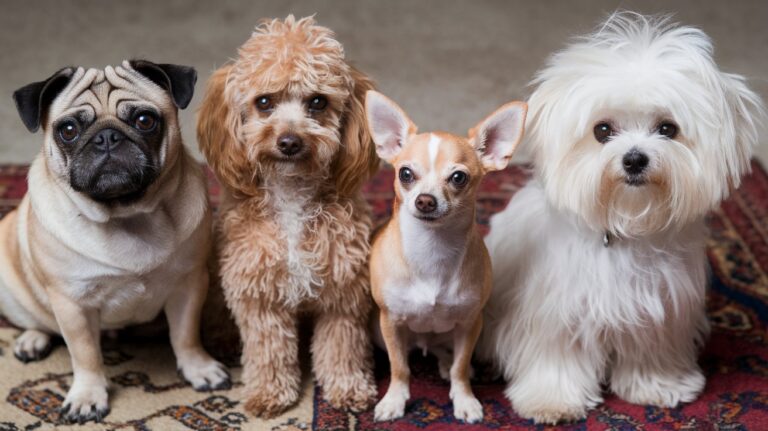The Barbet Ancient French Water Dog: 100% Comprehensive Guide
The Barbet, an ancient French water dog, is a breed known for its curly coat, friendly disposition, and versatile abilities. This guide delves into the history, characteristics, care requirements, and unique aspects of this charming breed, providing a well-researched and informative overview for anyone interested in learning more about the Barbet.
Table of Contents
ToggleThe History of the Barbet

Ancient Origins
The Barbet’s origins can be traced back to France, where it has been known for centuries. References to similar dogs date back to the 14th century, and the breed is thought to have played a role in the development of other water dogs and retrievers.
Role in Society
Historically, Barbets were used by sailors and hunters due to their excellent swimming abilities and retrieving skills. They were invaluable for retrieving waterfowl from marshes and lakes, showcasing their natural affinity for water and their keen intelligence.
Modern Revival
Despite their long history, Barbets nearly faced extinction in the 20th century. Dedicated breeders worked tirelessly to revive the breed, and today, Barbets are enjoying a resurgence in popularity as both working dogs and beloved family pets.
Physical Characteristics
Size and Build
Barbets are medium-sized dogs, with males typically standing between 21 and 24.5 inches tall and females slightly smaller at 20.5 to 22.5 inches. They are sturdy and well-built, with a strong, muscular frame that enables them to excel in swimming and retrieving tasks.
Coat and Color
One of the most distinctive features of the Barbet is its dense, curly coat. The coat is water-resistant, helping the dog stay warm and dry while working in wet conditions. Barbets come in various colors, including black, brown, gray, and fawn, often with white markings.
Facial Features
The Barbet’s expressive eyes are usually dark brown, giving them a friendly and intelligent appearance. Their ears are long and covered in curly hair, adding to their distinctive look.
Temperament and Personality
Friendly and Social
Barbets are known for their friendly and social nature. They tend to get along well with people, including children, and can be quite affectionate. Their gentle temperament makes them excellent family pets.
Intelligent and Trainable
Highly intelligent and eager to please, Barbets are relatively easy to train. They respond well to positive reinforcement methods and can excel in obedience and agility training.
Active and Playful
Barbets are active dogs that require regular exercise to stay healthy and happy. They enjoy outdoor activities, especially those involving water, and are always ready for a game of fetch or a swim.
Caring for Your Barbet
Grooming Needs
The Barbet’s curly coat requires regular grooming to prevent matting and tangling. Weekly brushing is essential, and many owners opt to trim their dog’s coat to a manageable length. Regular baths are also necessary to keep the coat clean and healthy.
Exercise Requirements
Barbets need plenty of exercise to stay fit and mentally stimulated. Daily walks, playtime, and opportunities to swim are ideal for keeping a Barbet happy and healthy. They thrive in homes with active families who can provide the necessary physical and mental stimulation.
Diet and Nutrition
A balanced diet is crucial for maintaining a Barbet’s health. High-quality dog food that meets their nutritional needs, along with regular vet check-ups, will help ensure your dog stays in top condition.
Health and Wellness
Common Health Issues
Like all breeds, Barbets are prone to certain health issues. These can include hip dysplasia, ear infections, and eye problems. Regular veterinary care and screenings can help catch and manage these conditions early.
Lifespan
Barbets typically live between 12 to 14 years. With proper care, a healthy diet, and regular exercise, many Barbets can enjoy a long, healthy life.
Preventative Care
Regular veterinary check-ups, vaccinations, and preventive treatments for parasites are essential for maintaining your Barbet’s health. Early detection of any potential health issues can lead to more effective treatment and better outcomes.
Training and Socialization
Early Socialization
Early socialization is key to raising a well-adjusted Barbet. Exposing your puppy to different people, environments, and experiences will help them develop into a confident and well-behaved adult dog.
Obedience Training
Barbets are quick learners and respond well to obedience training. Starting training at a young age and using positive reinforcement methods will yield the best results. Consistency and patience are crucial in training a Barbet.
Advanced Training
Given their intelligence and eagerness to work, Barbets can excel in advanced training and dog sports. Activities such as agility, obedience trials, and even water rescue can provide excellent outlets for their energy and skills.
Living with This Dog Breed
Living with this breed offers a unique blend of companionship, activity, and affection. This section explores what it’s like to share your life with this ancient French water dog, known for its intelligence, playful demeanor, and love for water.
Home Environment
Barbets thrive in homes where they have space to move around and explore. While they can adapt to apartment living with sufficient exercise, they truly shine in houses with yards where they can roam and play freely. Their love for water means they’ll appreciate access to ponds, lakes, or even a kiddie pool in warmer months.
Family Dynamics
Known for their friendly and gentle nature, Barbets are excellent companions for families. They have a natural affinity for children and enjoy being part of family activities. Their patient demeanor and playful spirit make them ideal playmates for kids, often forming strong bonds that endure for years.
Exercise and Activity Needs
Barbets are energetic dogs that require regular exercise to stay happy and healthy. Daily walks, runs, or swims are essential to keep them physically fit and mentally stimulated. They excel in activities such as fetch, agility training, and water sports, where they can showcase their natural athleticism and love for water.
Grooming and Coat Care
The Barbet’s curly coat is not just distinctive but also requires regular maintenance. Weekly brushing helps prevent mats and tangles, especially around the ears and tail. Some owners opt for professional grooming or trimming to keep the coat manageable. Regular baths are necessary to keep their coat clean and maintain its water-resistant properties.
Training and Socialization
With their intelligence and eagerness to please, Barbets respond well to positive reinforcement training methods. Early socialization is crucial to help them develop into well-rounded adults. Exposing them to different people, animals, and environments from a young age builds their confidence and ensures they interact well in various situations.
Health and Wellness
Like all breeds, Barbets are prone to certain health conditions, including hip dysplasia, ear infections, and eye issues. Regular vet check-ups, a balanced diet, and maintaining a healthy weight are essential for their overall well-being. Responsible breeding practices and early detection of health issues can contribute to a longer and healthier life for your Barbet.
Bonding and Companionship
Owning a Barbet is not just about care and training but also about forming a deep bond and companionship. They are known for their loyalty and affection towards their owners, often displaying a strong desire to be near their family members. Whether curling up next to you on the couch or joining you on outdoor adventures, Barbets thrive on companionship and love being an integral part of their human pack.
Personal Anecdote
Living with our Barbet, Luna, has been a joyous journey filled with laughter and memorable moments. Her boundless energy and playful antics keep us entertained daily, while her unwavering loyalty and affection remind us of the deep bond we share. From long walks in the park to weekend hikes and swimming adventures, Luna’s zest for life enriches our family in ways we never imagined.
Finding a Barbet

Choosing a Reputable Breeder
Finding a Barbet from a reputable breeder is crucial to ensuring you adopt a healthy and well-adjusted dog. Here are some steps to help you find a responsible breeder:
- Research Breeders: Start by researching breeders who specialize in Barbets. Look for those who have a good reputation within the Barbet community and who prioritize the health and welfare of their dogs.
- Visit the Breeder: Arrange to visit the breeder in person, if possible, to see their facilities and meet their dogs. A reputable breeder will be open and transparent about their breeding practices, health screenings, and living conditions of their dogs.
- Health Screenings: Ensure the breeder conducts health screenings for genetic conditions common in Barbets, such as hip dysplasia and eye disorders. They should provide you with health clearances for both parent dogs.
- Ask Questions: Don’t hesitate to ask the breeder questions about their breeding program, the temperament of their dogs, and their approach to socializing puppies. A responsible breeder will be knowledgeable and passionate about the breed.
- References and Reviews: Seek references from other puppy buyers or members of this dog breed community. Online reviews and testimonials can also provide insights into the breeder’s reputation and customer satisfaction.
- Contract and Support: A reputable breeder will offer a written contract that outlines the terms of sale, health guarantees, and support they provide after you bring your puppy home. They should be available to answer your questions and offer guidance throughout your dog’s life.
Rescue and Adoption
Adopting a dog from a rescue organization or shelter can be a rewarding way to provide a loving home to a dog in need. Here’s what to consider when adopting a Barbet:
- Rescue Organizations: Look for rescue organizations or breed-specific rescues that specialize in Barbets. These organizations rescue Barbets from shelters, owner surrenders, or other situations and provide them with necessary medical care and rehabilitation.
- Adoption Process: Each rescue organization will have its adoption process, which typically involves an application, interview, and possibly a home visit. Be prepared to provide information about your experience with dogs, lifestyle, and how you plan to care for a Barbet.
- Temperament Assessment: Rescue organizations often conduct temperament assessments to match dogs with suitable homes. They may also provide information about the dog’s history, behavior, and any special needs.
- Cost and Fees: Adoption fees from rescue organizations typically cover the cost of veterinary care, vaccinations, spaying or neutering, and sometimes microchipping. These fees support the rescue’s ongoing efforts to care for Barbets in need.
- Support and Transition: Rescue organizations are committed to ensuring successful adoptions. They may offer support and guidance as you integrate your new dog into your home, including advice on training, health care, and socialization.
What to Expect
Whether you choose to adopt from a breeder or rescue organization, it’s important to be patient and thorough in your search for this breed. Both options offer the opportunity to provide a loving and forever home to a wonderful dog. By taking the time to research and find the right fit for your lifestyle, you can enjoy a rewarding relationship with your Barbet for years to come.
The Barbet Community

Joining Breed Clubs and Associations
National and International Organizations
One of the best ways to immerse yourself in the Barbet community is by joining breed clubs and associations. National organizations such as the Barbet Club of America (BCA) and international groups like the Fédération Cynologique Internationale (FCI) provide platforms for Barbet owners and enthusiasts to connect, share information, and support each other.
These organizations often host events, publish newsletters, and maintain online forums where members can discuss everything from training tips to health concerns. Being part of a breed club offers valuable resources and a sense of belonging to a larger community dedicated to the well-being of this dog breeds.
Local and Regional Groups
In addition to national and international organizations, there are many local and regional these breeds clubs. These smaller groups often organize meet-ups, training sessions, and social events where Barbet owners can gather and share experiences. Participating in local clubs can be particularly beneficial for new Barbet owners, providing hands-on support and opportunities to see the breed in action.
Events and Activities
Dog Shows and Competitions
Dog shows and competitions are exciting venues for showcasing the Barbet’s unique qualities and abilities. These events range from conformation shows, where dogs are judged on how well they conform to breed standards, to performance events like agility, obedience, and water trials.
Participating in these events not only highlights the Barbet’s talents but also fosters a deeper bond between you and your dog. It’s a great way to meet other these breeds owners, exchange tips, and celebrate the breed’s versatility.
Social Gatherings and Playdates
Many these dog breeds clubs organize social gatherings and playdates, providing a fun and relaxed environment for dogs and their owners to interact. These events can be held at local parks, beaches, or dog-friendly venues, offering a chance for Barbets to play together and for owners to network and share advice.
Personal anecdote: I remember attending my first this breed dog playdate with Max at a nearby lake. Watching him romp around with other Barbets, diving into the water and playing fetch, was a joyful experience. It was also a fantastic opportunity to connect with other owners and learn from their experiences with the breed.
Online Communities and Social Media
Forums and Discussion Groups
Online forums and discussion groups are invaluable resources for these breeds owners, providing a platform to ask questions, share stories, and seek advice. Websites like Reddit and breed-specific forums offer a wealth of information and a supportive community of fellow enthusiasts.
Social Media Platforms
Social media platforms such as Facebook, Instagram, and Twitter are also popular among these dogs owners. Many breed clubs and individual owners maintain active pages and groups, sharing photos, videos, and updates about their dogs. These platforms are excellent for staying connected with the dog community and keeping up with the latest news and events.
Educational Resources
Seminars and Workshops
Breed clubs and organizations often host seminars and workshops on various topics related to this dog breed. These educational events cover subjects such as grooming, training, health care, and breeding. Attending these workshops can deepen your understanding of the breed and provide practical skills for caring for your Barbet.
Books and Publications
There are several books and publications dedicated to these dog breeds, offering in-depth information about the breed’s history, characteristics, and care. Subscribing to newsletters and magazines published by breed clubs can keep you informed about current trends, health updates, and upcoming events in these breeds world.
Volunteering and Giving Back
Rescue and Adoption
Many these dog breed clubs and associations support rescue and adoption efforts, helping to find homes for Barbets in need. Volunteering with these organizations or adopting a rescue this breed can be a deeply rewarding experience, contributing to the well-being of the breed and giving a dog a second chance at a happy life.
Community Outreach
Participating in community outreach programs, such as therapy dog visits or educational demonstrations, allows you and your dog to give back to the community. These activities not only highlight the Barbet’s gentle and friendly nature but also promote responsible dog ownership and breed awareness.
Building Lifelong Connections
Friendships and Networking
Being part of this dog breed community often leads to lasting friendships and valuable networking opportunities. Whether through local meet-ups, online groups, or national events, connecting with other Barbet owners can enrich your experience with the breed and provide a support system for any challenges you may face.
Personal Anecdote
Reflecting on my journey with Max, I am grateful for the connections I’ve made within the Barbet community. From the friendly advice of experienced owners to the camaraderie at events and gatherings, the sense of community has been invaluable. These relationships have not only enhanced my understanding of the breed but also created a network of friends who share a common passion for the Barbet.
Conclusion
Dog this breed is a remarkable breed with a rich history, unique characteristics, and a loving nature. Whether as a working dog, a family pet, or a loyal companion, the Barbet excels in various roles. By understanding their needs and providing proper care, you can ensure a happy and fulfilling life for your dog. This comprehensive guide has covered the essential aspects of the dog, offering valuable insights for anyone considering welcoming this wonderful breed into their life.
Final Thoughts
Owning this dog breed is a rewarding experience filled with joy, love, and companionship. Their intelligence, playful nature, and adaptability make them an excellent choice for active families and individuals. By investing time in proper training, socialization, and care, you can enjoy a long and happy relationship with your dog.





